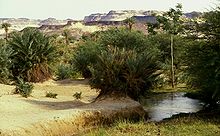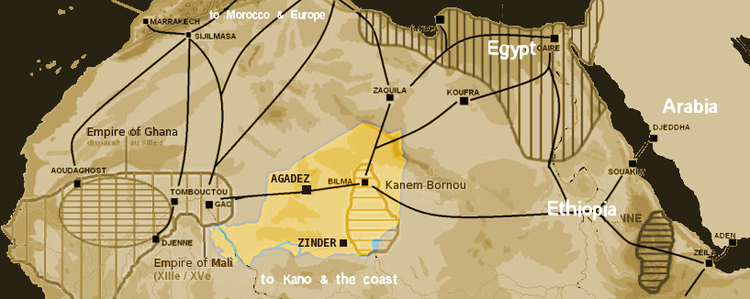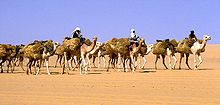Trans-Saharan trade

Trans-Saharan trade is
As a desert, the Sahara is now a hostile expanse that separates the Mediterranean economy from the economy of the Niger River Basin. As Fernand Braudel points out, crossing such a zone, especially without mechanized transport, is worthwhile only when exceptional circumstances cause the expected gain to outweigh the cost and the danger.[2] Trade was conducted by caravans of camels. According to Maghrebi explorer Ibn Battuta, who once traveled with a caravan, an average one would amount to 1,000 camels, but some caravans were as large as 12,000.[3][4] The caravans would be guided by highly-paid Berbers, who knew the desert and could ensure protection from fellow desert nomads. The caravans' survival relied on careful coordination: runners would be sent ahead to oases for water to be shipped out to the caravan when it was still several days away, as the caravans could usually not carry enough to make the full journey. In the mid-14th century CE, Ibn Battuta crossed the desert from Sijilmasa via the salt mines at Taghaza to the oasis of Oualata. A guide was sent ahead, and water was brought over a four-day journey from Oualata to meet the caravan.[5]
Culture and religion were also exchanged on the trans-Saharan trade routes. Many West African states eventually adopted Arabic writing and the religion of North Africa, resulting in these states' absorption into the Muslim world.[6]
Early trans-Saharan trade


Ancient trade spanned the northeastern corner of the Sahara in the
The overland route through the
The
The westernmost of the three central routes was the Ghadames Road, which ran from the Niger River at Gao north to Ghat and Ghadames before terminating at Tripoli.

Next was the easiest of the three routes: the
Another Libyan route was Benghazi to Kufra to the lands of the Wadai Empire between Lake Chad and Darfur.[15]
The western routes were the
To the east, three ancient routes connected the south to the Mediterranean. The herdsmen of the Fezzan of Libya, known as the Garamantes, controlled these routes as early as 1500 BCE. From their capital of Germa in the Wadi Ajal, the Garamantean Empire raided north to the sea and south into the Sahel. By the 4th century BCE, the independent city-states of Phoenicia had expanded their control to the territory and routes once held by the Garamantes.[13] Shillington states that existing contact with the Mediterranean received added incentive with the growth of the port city of Carthage. Founded c. 800 BCE, Carthage became one terminus for West African gold, ivory, and slaves. West Africa received salt, cloth, beads, and metal goods. Shillington proceeds to identify this trade route as the source for West African iron smelting.[17] Trade continued into Roman times. Although there are Classical references to direct travel from the Mediterranean to West Africa (Daniels, p. 22f), most of this trade was conducted through middlemen, inhabiting the area and aware of passages through the drying lands.[18] The Legio III Augusta subsequently secured these routes on behalf of Rome by the 1st century CE, safeguarding the southern border of the empire for two and half centuries.[13]
The Garamantes also engaged in the
In the early
Introduction of the camel
The earliest evidence for domesticated camels in the region dates from the 3rd century. Used by the Berbers, they enabled more regular contact across the entire width of the Sahara, but regular trade routes did not develop until the beginnings of the Islamic conversion of West Africa in the 7th and 8th centuries.[22] Two main trade routes developed. The first ran through the western desert from modern Morocco to the Niger bend, the second from modern Tunisia to the Lake Chad area. These stretches were relatively short and had the essential network of occasional oases that established the routing as inexorably as pins in a map. Further east of the Fezzan with its trade route through the valley of Kaouar to Lake Chad, Libya was impassable due to its lack of oases and fierce sandstorms.[23] A route from the Niger bend to Egypt was abandoned in the 10th century due to its dangers.[citation needed]
Spread of Islam
Several trade routes became established, perhaps the most important terminating in

Unlike Ghana, Mali was a Muslim kingdom since its foundation, and under it, the gold–salt trade continued. Other, less important trade goods were slaves,
The eastern trans-Saharan route led to the development of the long-lived
The
Saharan triangle trade
The rise of the Ghana Empire, in what is now Mali, Senegal, and southern Mauritania, accompanied the increase in trans-Saharan trade. Northern economies were short of gold but at times controlled salt mines such as Taghaza in the Sahara, whereas West African countries like Wangara had plenty of gold but needed salt. Taghaza, a trading and mining outpost where Ibn Battuta recorded the buildings were made of salt, rose to preeminence in the salt trade under the hegemony of the Almoravid Empire.[28] The salt was mined by slaves and purchased with manufactured goods from Sijilmasa.[28] Miners cut thin rectangular slabs of salt directly out of the desert floor, and caravan merchants transported them south, charging a transportation fee of almost 80% of the salt's value.[28] The salt was traded at the market of Timbuktu almost weight for weight with gold.[28] The gold, in the form of bricks, bars, blank coins, and gold dust went to Sijilmasa, from which it went out to Mediterranean ports and in which it was struck into Almoravid dinars.[28]
Spread of Islam
The spread of Islam to sub-Saharan African was linked to trans-Saharan trade. Islam spread via trade routes, and Africans converting to Islam increased trade and commerce which increased the trade's population.[29]
Historians give many reasons for the spread of Islam facilitating trade. Islam established common values and rules upon which trade was conducted.[29] It created a network of believers who trust each other and therefore trade with each other even if they do not personally know each other.[30] Such trade networks existed before Islam but on a much smaller scale. The spread of Islam increased the number of nodes in the network and decreased its vulnerability.[31] The use of Arabic as a common language of trade and the increase of literacy through Quranic schools, also facilitated commerce.[32]
Muslim merchants conducting commerce also gradually spread Islam along their trade network. Social interactions with Muslim merchants led many Africans to convert to Islam, and many merchants married local women and raised their children as Muslims.[32]
Islam spread into Western Sudan by the end of the 10th century, into Chad by the 11th century, and into Hausa lands in 12th and 13th centuries. By 1200, many ruling elites in Western Africa had converted to Islam, and from 1200 to 1500 saw a significant conversion to Islam in Africa.[33]
Decline of trans-Saharan trade
The
Although much reduced, trans-Saharan trade continued. But trade routes to the West African coast became increasingly easy, particularly after the French invasion of the Sahel in the 1890s and subsequent construction of railways to the interior. A railway line from Dakar to Algiers via the Niger bend was planned but never constructed. With the independence of nations in the region in the 1960s, the north–south routes were severed by national boundaries. National governments were hostile to Tuareg nationalism and so made few efforts to maintain or support trans-Saharan trade, and the Tuareg rebellion of the 1990s and Algerian Civil War further disrupted routes, with many roads closed.

Traditional caravan routes are largely void of camels, but the shorter Azalai routes from Agadez to Bilma and Timbuktu to Taoudenni are still regularly—if lightly—used. Some members of the Tuareg still use the traditional trade routes, often traveling 2,400 km (1,500 mi) and six months out of every year by camel across the Sahara trading in salt carried from the desert interior to communities on the desert edges.[34]
The future of trans-Saharan trade
The African Union and African Development Bank support the Trans-Sahara Highway from Algiers to Lagos via Tamanrasset which aims to stimulate trans-Saharan trade. The route is paved except for a 120 mi (200 km) section in northern Niger, but border restrictions still hamper traffic. Only a few trucks carry trans-Saharan trade, particularly fuel and salt. Three other highways across the Sahara are proposed: for further details see Trans-African Highways. Building the highways is difficult because of sandstorms.
See also
- Trans-Sahara Highway
- Neolithic Subpluvial
- Trans-Saharan slave trade
References
- ISBN 0-333-59957-8.
- ^ Braudel, Fernand (1984). The Ghana Empire (article). Civilization and Capitalism. Vol. III. Harper & Row. Retrieved 2020-05-29.
- ^ Rouge, David (21 February 2007). "Saharan salt caravans ply ancient route". Reuters.
- ^ "An African Pilgrim-King and a World-Traveler: Mansa Musa and Ibn Battuta".
- ISBN 978-0-904180-37-4.
- ^ Bovill, E.W. (1968). Golden Trade of the Moors. Oxford University Press.
- ISBN 0-500-05074-0.
- ISBN 3-927552-12-7..)
{{cite book}}: CS1 maint: location missing publisher (link) (See on-line posts: [1] and [2] - ^ "Trade in Ancient Egypt". World History Encyclopedia. Retrieved 2020-05-29.
- ^ "Ship - History of ships". Encyclopedia Britannica. Retrieved 2020-05-29.
- ^ Jobbins, Jenny (13–19 November 2003). "The 40 days' nightmare". Al-Ahram (664). Cairo, Egypt.
- ^ Smith, Stuart Tyson. "Nubia: History". University of California Santa Barbara, Department of Anthropology. Retrieved January 21, 2009.
- ^ ISBN 1-55876-405-4.
- JSTOR 1776898.
- ^ JSTOR 41719405.
- ISBN 978-0-511-57545-7
- ^ Shillington (1995). p. 46.
- ISBN 0-902675-04-4.
- ^ David Mattingly. "The Garamantes and the Origins of Saharan Trade". Trade in the Ancient Sahara and Beyond. Cambridge University Press. pp. 27–28.
- ^ a b c d Keith R. Bradley. "Apuleius and the sub-Saharan slave trade". Apuleius and Antonine Rome: Historical Essays. p. 177.
- ^ a b c d e f g Andrew Wilson. "Saharan Exports to the Roman World". Trade in the Ancient Sahara and Beyond. Cambridge University Press. pp. 192–3.
- ^ ISBN 1-85065-311-9. Archived from the original on 1998-12-06.)
{{cite book}}: CS1 maint: location missing publisher (link - ]
- ^ "Ibn Battuta's Trip: Part Twelve – Journey to West Africa (1351–1353)". Archived from the original on June 9, 2010.
- ^ a b c Ralph A. Austen. Trans-Saharan Africa in World History. Oxford University Press. p. 31.
- ISBN 0-415-25247-4.
- ^ "The impact of the slave trade on Africa". April 1998.
- ^ ISBN 978-1-4773-1135-6.
- ^ a b Toyin Falola, Matthew M. Heaton. A History of Nigeria. pp. 32–33.
- ^ Anne Haour. "What made Islamic Trade Distinctive, as Compared to Pre-Islamic Trade?". Trade in the Ancient Sahara and Beyond. Cambridge University Press. pp. 82–83.
- ^ Anne Haour. "What made Islamic Trade Distinctive, as Compared to Pre-Islamic Trade?". Trade in the Ancient Sahara and Beyond. Cambridge University Press. pp. 95–96.
- ^ ISBN 9781317525523.
- ^ Patricia Pearson. "The World of Atlantic before the "Atlantic World"". In Toyin Falola, Kevin David Roberts (ed.). The Atlantic World, 1450-2000. Indiana University Press. pp. 10–11.
- National Geographic Channel. This episode follows a Tuareg tribe across the Sahara for six months by camel.
Further reading
- Boahen, Albert Adu (1964). Britain, the Sahara and the Western Sudan 1788–1861. Oxford.
{{cite book}}: CS1 maint: location missing publisher (link) - Bovill, Edward William (1995). The Golden Trade of the Moors. Princeton: Markus Wiener. ISBN 1-55876-091-1.
- Harden, Donald (1971) [1962]. The Phoenicians. Harmondsworth: Penguin.
- ISBN 1-57958-245-1.
- Warmington, B. H. (1964) [1960]. Carthage. Harmondsworth: Penguin.
- Masonen, Pekka (1997). "Trans-Saharan Trade and the West African Discovery of the Mediterranean World". In Sabour, M'hammad; Vikør, Knut S. (eds.). Ethnic Encounter and Culture Change. Bergen. ISBN 1-85065-311-9. Archived from the original on 1998-12-06.)
{{cite book}}: CS1 maint: location missing publisher (link - Ross, Eric (2011). "A historical geography of the trans-Saharan trade". In Krätli, Graziano; Lydon, Ghislaine (eds.). The Trans-Saharan Book Trade: Manuscript Culture, Arabic Literacy and Intellectual History in Muslim Africa. Leiden: Brill. pp. 1–34. ISBN 978-90-04-18742-9.
- "The Trans-Saharan Gold Trade 7th–14th Century". Museum of Modern Art.
- Chegrouche, Lagha (2010). "Géopolitique transsaharienne de l'énergie". Revue Géopolitique (in French). Archived from the original on November 30, 2010.
- Chegrouche, Lagha (2010). "Géopolitique transsaharienne de l'énergie, le jeu et l'enjeu?". Revue de l'énergie, Etude (in French).
